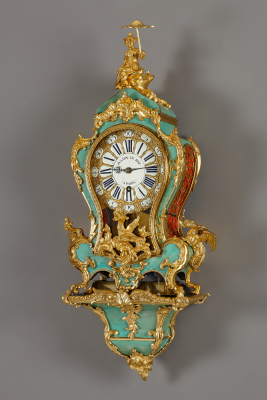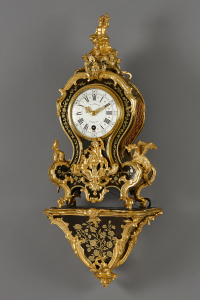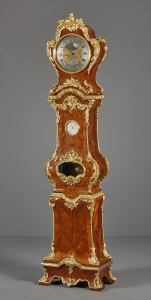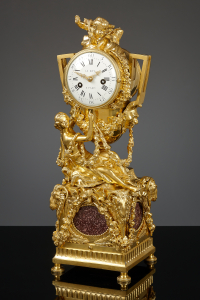French Louis XV console clock
French Louis XV console clock
Movement
The fourteen-day movement is driven by a spring barrel. It is regulated by an anchor escapement in combination with a pendulum hung on silk. The movement has a pull quarter repeat with two hammers on a single bell. The movement is signed both on the dial and on the back.
Dial
The enamelled bronze dial features twenty-five white enamelled cartouches, twelve of which are decorated with blue enamelled Roman numerals indicating the hours. In a ring around these are the minutes in black enamelled Arab numerals. The hands are blued steel. The central cartouche bears the signature Julien Le Roy à Paris.
Le Roy
The Le Roy dynasty ranked among the most prominent clockmakers in history, providing multiple generations with horlogers who stood out as some of the most highly acclaimed timepiece artisans of their day. The heyday of the Le Roys began with Julien Le Roy (1686-1759), who established the dynasty in Paris. Le Roy’s peers considered him one of the, perhaps even the most influential clockmaker of his time. He was not only an exceptional craftsman, but also a scholar who contributed to the Encyclopédie’s section on timepieces, and was praised by Voltaire as being single-handedly responsible for the superiority of the French clockmaking industry in the eighteenth century.
Case
The sharply waisted oak case is veneered with corne vert (green-stained horn). The whole features lavish amounts of gilt bronze, and is decorated with chinoiserie elements, such as dragons on the “knees” and a Chinese man atop the case.
Balthasar Lieutaud
The case is triple-stamped B. Lieutaud upon the reverse. Lieutaud was one of the most important Parisian furniture-makers of the Louis XV period and early neoclassicism. Born into a family of renowned furniture-makers, he became a master furniture-maker in 1749, opening a workshop on Rue de la Pelleterie. He soon specialised in cases for regulator and cartel clocks, sourcing his bronzes from the best bronze casters such as Charles Grimpelle, Caffieri and Jean-Charles Delafosse.
C Couronné
Several of the bronze ornaments are stamped with the C couronné (crowned C).
An edict issued in 1745 made it compulsory for bronzeworkers to stamp their works with a characteristic small letter: a C surmounted with a crown, which indicated that they were liable to pay tax. This applied to both the ornaments and the furniture for which they were used.
The mark, whose dimensions are mere millimetres, long represented a conundrum for researchers: was it the signature of the bronzier Caffieri or the fondeur Colson, or the stamp of furniture-maker Cressent? It was not until 1924 that Henri Nocq’s Le Poinçon de Paris described the mark as a tax symbol for bronze objects and components that was used from 1745 to 1749. Much like all other forms of taxation, the crowned C was deeply unpopular, and craftsmen brought multiple court cases against the state to dispute the decision.
Nevertheless, the edict became effective in February 1745, from which point on it applied to all old and new works of bronze, pure copper, cast iron and alloyed copper, be it forged, cut, hammered, shaved, engraved, gilt, silvered or tinted, without exception.
All craftsmen were required to bring their works to the hallmark office at the “cul-de-sac des Bourdonnais” in the Halles quarter to have them stamped and pay the required royalties. An important detail is that this all occurred during the War of the Austrian Succession – in other words, a period during which the country’s military needs were severe. After the signature of the Peace of Aix-la-Chapelle in February 1749, the “new minor taxes” were abolished.
Yet all copperwork produced or sold in the intervening four years had to bear the hallmark in question. It is therefore possible to find the mark on pieces predating 1745 that were provided with a new layer of gilding or sold during this period. This is the case with various items of furniture by André-Charles Boulle from the Louis XIV period.
- Period
- ca. 1745
- Material
- oak case, veneered with green-stained horn, and fire-gilt bronze, enameled cartouches
- Signature
- Julien le Roy à Paris
- Dimensions
- 77 x 32 x 17 cm
Global shipping available







